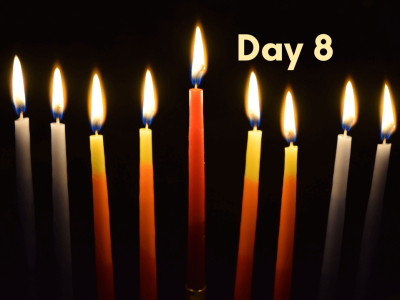Decoding Hebrews – Chapter 1
Decoding Hebrews – Chapter 1
Hebrews Decoded:
Chapter 1 ~ Is Jesus God?
Before we dive into Hebrews chapter 1, I want to take a moment to remind you that if you haven’t yet watched the introductory video to this series – HEBREWS INTRO, it’s crucial you do so before moving on to this chapter. The intro provides context on the “who, what, when, where, and why” of the book of Hebrews, laying a foundation for what follows. So, I encourage you to watch that first.
With that in mind, the book of Hebrews is foundational to the Christian faith. Its importance cannot be overstated, as a misunderstanding of Hebrews can lead to a misinterpretation of many other scriptures. This letter, likely connected to Paul, though possibly written by someone like Barnabas, is crucial to understanding the new covenant. The writer’s insight and approach in this letter are extraordinary, and everything starts to unfold in chapter 1. The author’s brilliance shines through as he establishes key theological themes.
Let’s jump into the text. Read with me Hebrews 1:1-4:
- “God, who at various times and in various ways spoke in time past to the fathers by the prophets,
- has in these last days spoken to us by His Son, whom He has appointed heir of all things, through whom also He made the worlds,
- who being the brightness of His glory and the express image of His person, and upholding all things by the word of His power, when He had by Himself purged our sins, sat down at the right hand of the Majesty on high,
- having become so much better than the angels, as He has by inheritance obtained a more excellent name than they.”
There is so much packed into these four verses that we could spend hours discussing them. First, let’s address something that many dispensationalists might point to. Verse 1 is often cited to support the idea of “dispensations”—a view that God deals with humanity in different ways at different times. In this view, God had different “rules” for different ages, like the age of the law and now the age of grace. The theory proposes that there are separate dispensations, like one for Adam to Noah, another from Noah to Moses, and so on. While this is a popular interpretation, it’s important to note that this specific doctrine doesn’t hold up biblically. It is a framework created by seminary students to try to categorize Scripture in a way that fits with our Western, Greco-Roman mindset, which tends to crave neat divisions and categories. However, the Scriptures don’t allow us to force them into such boxes.
In Hebrews 1, the author isn’t teaching dispensationalism but is rather emphasizing that in the past, God spoke through the prophets, but now He speaks through His Son. This isn’t about “ages” in the sense that dispensationalists describe, but rather it’s about the progressive revelation of God—moving from the prophets to the ultimate revelation through His Son, Jesus Christ.
One more point about dispensationalism: one of the greatest misconceptions tied to it is the belief that Israel and the church are completely separate entities. In reality, Israel and the church are intimately connected. Paul makes this clear in Ephesians 2 when he says that Gentiles, who were once far off, have now been brought near through the blood of Christ. As believers in Christ, Gentiles are grafted into Israel. There’s no longer a separation between Jew and Gentile in God’s eyes. The two are now one in Christ. We’re going to unpack this further in future teachings, but for now, if you’re unsure or confused about how Israel connects to us as believers, I highly recommend watching “Identity Crisis.” It’s one of our most impactful teachings and has been viewed by millions.
Now, let’s move on to verse 2, where it says that the Messiah is the “heir of all things.” This is a profound statement, especially when you consider Romans 8:17, where Paul tells us that as children of God, we are “heirs of God and joint heirs with Christ.” Galatians 3:29 also echoes this theme, stating that if we belong to Christ, we are Abraham’s seed and heirs according to the promise. Christ is the ultimate heir—the Son of the living God, the Prince to the King.
In verse 3, we see something truly fascinating. It says, “through whom He also made the worlds.” This is a game-changer. If Christ was merely born in Bethlehem 2,000 years ago, then how could He have created the world? Some might argue, “Well, Christ was only in God’s mind before He was born.” But that’s not what the verse says. It clearly states that through Christ, God created the worlds. This idea is further affirmed in Revelation 3:14 and Colossians 1:15-17. In fact, Colossians says, “By Him all things were created… and in Him all things consist.”
This brings us to an important point: if Christ is the Creator and not just the Messiah who came in the flesh, then He is not merely a high priest; He is the Creator of the universe. Everything—every visible and invisible thing—is held together by Him. Hebrews is setting the stage for us to understand that Jesus isn’t just a man or a teacher; He is the eternal Creator, holding everything together with His powerful word.
Let’s go back to the text. Verse 4 tells us that Jesus, after purging our sins through His own sacrifice, “sat down at the right hand of the Majesty on high.” This is a key point. Jesus, by His own blood, accomplished what no one else could—He forgave our sins and then took His rightful place next to God. The Majesty on high refers to God the Father, and this symbolizes the sharing of authority. The Son is now seated at the same throne, having earned the right to rule.
This connection between the Father and the Son is crucial. It ties into Philippians 2:10-11, where Paul writes that “at the name of Jesus, every knee should bow… and every tongue confess that Jesus Christ is Lord to the glory of God the Father.” Interestingly, this is a direct quote from Isaiah 45:23, where God Himself says, “To Me, every knee shall bow, every tongue shall swear allegiance.” So, in Philippians, Paul applies this statement to Jesus, affirming His divine status. This passage underscores the mystery of Christ’s divinity.
The writer of Hebrews picks up on this and says, “To which of the angels did God ever say, ‘You are My Son; today I have begotten You?'” (Hebrews 1:5). The answer, of course, is none. Jesus is unique in this way—He is the Son, not a mere angel or servant. The writer uses Old Testament quotes from Psalm 2 and 2 Samuel to show that Jesus is far superior to angels. In fact, He is the object of their worship.
Now, why does the author emphasize angels in this way? In first-century Judaism, there was a significant focus on angels. Many Jewish traditions elevated angels to a level almost equal to God. But the writer of Hebrews is addressing this false view, declaring that Jesus is far superior to the angels—He is the Creator and the one to whom angels must bow.
As we move forward in Hebrews, we’ll see how the writer continues to establish the superiority of Christ. But for now, let’s take a moment to reflect on what we’ve learned. The foundation of the new covenant, the relationship between God and humanity, is all built upon Christ’s preeminence. His divinity, His role as Creator, His authority over all things—these are the essential truths we must grasp before we can fully understand the book of Hebrews and the high priesthood of Jesus Christ.
This section of the article continues the exploration of the divinity of Yeshua (Jesus) and the theological implications of the relationship between God the Father, Son, and Holy Spirit, especially in the context of Hebrews. It presents various analogies to help readers grasp the deep mystery of the Trinity and the role of Yeshua within this divine framework. Here’s a breakdown of the key points:
1. Analogies to Explain the Trinity:
- The Sun, Light, and Warmth:
The Father is like the unseen sun, the Son is like the visible rays of light, and the Holy Spirit is like the warmth that touches us. This highlights the unity of essence between the Father, Son, and Holy Spirit, while also showing how they function in different ways. - Ocean, Waves, and Mist:
The Father is like the deep ocean, Yeshua is like the waves, and the Holy Spirit is like the mist. Yeshua is the visible expression of the ocean (the Father), bringing the depth and essence of the ocean to us. The waves bring us something from the deep, but the mist that surrounds us represents the active presence of the Holy Spirit. - CEO Becoming an Intern:
This analogy emphasizes Yeshua’s submission in His role while still retaining His divine essence. Just as a CEO can temporarily step down into a lower position while still being the CEO, Yeshua humbled Himself to take on a human form without ceasing to be God. - King and His Son:
Yeshua is likened to the prince, who, though in a different role, is still fully of the same essence as the king. This underscores the idea of submission in role but equality in essence.
2. Theological Implications of Yeshua’s Divinity:
- Yeshua’s Role as Mediator:
The article underscores that Yeshua’s divine nature is necessary for Him to be the mediator between God and humanity. A mere human cannot fully represent God or man in the way Yeshua does. His divinity enables Him to transcend time and mediate for both past and future sins, making the new covenant superior to the old. - The Bridegroom:
A crucial part is the theological notion that Yeshua is the bridegroom of Israel, as foretold in the Old Testament and confirmed in the New Testament. This connects Him directly to God, as God in the Old Testament is also described as Israel’s Husband. The author points out that this identification of Yeshua as the bridegroom would have been considered blasphemous by the Pharisees, as it links Yeshua with the divine identity of God.
3. Yeshua as the Manifestation of God:
- God as the Creator and Husband:
The connection between God and Yeshua is explored through the Old Testament prophecies that speak of God as Israel’s Husband and Redeemer. Yeshua, being called the Redeemer, takes on the same role, making Him not just a human, but a divine being who fulfills God’s covenant promises. - The Angel of the Lord and Manifestations of God:
The article discusses the idea that God has manifested Himself in various forms throughout history, such as the Angel of the Lord in the Old Testament, which is a manifestation of God in a human-like form before the incarnation of Yeshua.
4. Hebrews and the New Covenant:
- Pre-eminence of Yeshua:
The author of Hebrews emphasizes that Yeshua is not just a human being or a high priest; He is the divine manifestation of God. The entirety of the new covenant hinges on understanding Yeshua’s divinity. His role as mediator between God and man is central to the new covenant, and without recognizing Him as God, the covenant loses its foundation. - Better Mediator, Better Covenant:
Hebrews 7:22 and 9:15 are used to explain why Yeshua is the guarantor of a better covenant. His divine nature makes Him the only suitable mediator who can represent both God and humanity fully. His sacrifice transcends time and reaches back to Adam’s sin, covering all humanity’s sins, past and future.
5. Divine Light:
This is a powerful image from Genesis to Revelation, where the divine light that began at creation (Genesis 1:1) will ultimately return to light the world at the end of time (Revelation 22). Yeshua, as the Word made flesh, is that light—essential to creation and redemption.
Theological Themes:
- The Divinity of Yeshua: This is a key theme throughout the article. Yeshua is presented as fully divine and fully human, with His divinity being necessary for the new covenant to function as a redemptive act.
- The Role of the Holy Spirit: The Holy Spirit’s work in the believer’s life is central to the experience of God’s presence.
- The Nature of the Trinity: The analogies used (sun, waves, and ocean) help explain the relationship between the Father, Son, and Holy Spirit in a way that is relatable, yet still mysterious.
Final Thoughts:
The understanding of Yeshua’s nature as both divine and human is critical for comprehending the new covenant. Without this understanding, the full depth of the relationship between God and humanity through Yeshua cannot be realized.
Watch the full teaching here:
https://www.youtube.com/watch?v=ic2s_hV55kg
Full transcript download:












